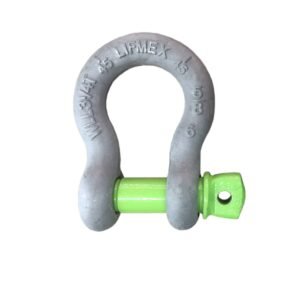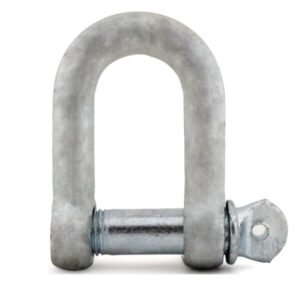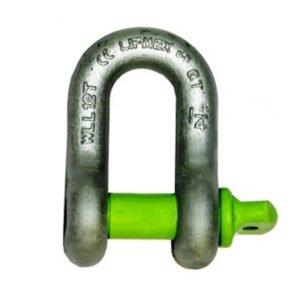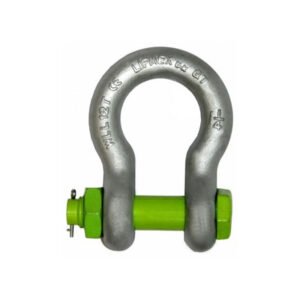Shackles are one of the most essential and versatile rigging equipment for any project that involves lifting, hoisting, or towing heavy loads. Whether you need to connect chains, ropes, slings, or other lifting components, shackles can provide a secure and reliable connection that can withstand high loads and harsh conditions.
But how do you choose the right shackles for your rigging and lifting needs? What are the different types, sizes, and specifications of shackles? How do you use and maintain shackles safely and efficiently?
In this ultimate guide, we will answer all these questions and more. We will cover everything you need to know about shackles, from their features and benefits to their best practices and tips. We will also show you how to find the best shackles for your project, and where to buy them from a trusted and reputable supplier.
By the end of this guide, you will have a comprehensive understanding of shackles and how to use them for your rigging and lifting purposes. You will also discover why Shabbir Enterprises L.L.C is one of the leading shackles suppliers in UAE, offering a wide range of high-quality and affordable shackles for various industries and applications.
What are Shackles?
Shackles are devices used to connect two or more lifting components, such as chains, ropes, slings, hooks, or eye bolts. They consist of two main parts: a body and a pin. The body is usually U-shaped or bow-shaped, and the pin is either a screw pin or a bolt that goes through the body and secures the connection.
Shackles are also known as clevises, gyves, or U-bolts, depending on the shape and type of the body and pin. They are made of metal, usually steel or alloy steel, and can be coated or galvanized for corrosion resistance and durability.
Shackles are widely used in rigging and lifting operations, such as construction, engineering, mining, oil and gas, marine, and transportation. They can handle heavy loads and withstand high stresses and strains, making them ideal for lifting, hoisting, towing, anchoring, or suspending objects.
Shackles are also used in other applications, such as sailing, climbing, rescue, or recreation. They can be attached to ropes, wires, cables, or chains to create loops, knots, or splices. They can also be used as fasteners, connectors, or adjusters for various equipment and accessories.
Types of Shackles
There are many types of shackles available in the market, each with its features and benefits. The most common types are:
Bow shackles
These shackles have a bow-shaped body and a screw pin or a bolt. Referred to as anchor connections, these are commonly employed for anchoring or mooring. Featuring a large, rounded body, they excel in accommodating multiple or angular loads. Compared to D connections, they offer greater flexibility and adaptability, adjusting to various directions and movements. However, their thinner and narrower body makes them weaker and less durable than D connections, susceptible to deformation or breakage under high loads or stresses.
Get it now
D shackles
These shackles have a D-shaped body and a screw pin or a bolt. Termed chain connections, these devices are commonly utilized for linking chains or slings. Featuring a small, straight body capable of managing high loads and stresses, they outperform bow alternatives in strength and durability due to a thicker, wider body that resists deformation or breakage. However, their flexibility and adaptability fall short compared to bow variations, accommodating only single or linear loads. They are also more susceptible to side loading or twisting, which may diminish their strength and safety.
Get it now
Screw-pin shackles
These shackles have a pin that can be screwed or unscrewed by hand. Known as pin connections, these feature a simple and easy pin mechanism, ideal for quick attachment and detachment in temporary or non-permanent connections. Their convenience and versatility make them suitable for various applications and environments. However, they are also less stable and secure than bolt-type shackles, as they can loosen or fall out due to vibration or movement. They also require regular inspection and maintenance, as they can corrode or damage over time.
Get it now
Bolt-type shackles
These shackles have a pin that is secured by a nut and a cotter pin. Referred to as nut connections, these feature a complex and secure pin mechanism suitable for permanent or long-term use. They provide enhanced stability and security compared to screw-pin alternatives. With a double locking system preventing pin loosening or falling out, they ensure heightened safety and reliability. However, their attachment and detachment are less convenient and versatile, requiring tools and time. Additionally, the presence of more parts and components can result in increased cost and weight.
Get it now
Safety shackles
These shackles have a special design and feature that enhance their safety and performance. Known for high performance, these exceed standard quality and are ideal for critical applications, handling higher loads and stresses. Their enhanced resistance and durability come from a special coating or galvanizing, protecting against corrosion and damage. Examples of safety solutions include:
-
- Green pin shackles: These have a green pin that indicates their load capacity and safety factor. They are also marked with the manufacturer’s name, trademark, and batch number. They are made of alloy steel and quenched and tempered for extra strength and durability. They are also tested and certified by third-party agencies to ensure their quality and compliance.
- Crosby shackles: These have a red pin that indicates their load capacity and safety factor. They are also marked with the manufacturer’s name, trademark, and batch number. They are made of alloy steel and quenched and tempered for extra strength and durability. They are also tested and certified by third-party agencies to ensure their quality and compliance.
- Van Beest shackles: These have a yellow pin that indicates their load capacity and safety factor. They are also marked with the manufacturer’s name, trademark, and batch number. They are made of alloy steel and quenched and tempered for extra strength and durability. They are also tested and certified by third-party agencies to ensure their quality and compliance.
How to Choose the Right Shackles for Your Project
Choosing the right shackles for your project is crucial, as it can affect the safety and efficiency of your rigging and lifting operations. There are many factors to consider when choosing shackles, such as:
Load capacity
This is the maximum weight that the shackle can safely support. It is usually expressed in tons or kilograms. You should always choose a shackle that has a load capacity equal to or greater than the weight of the load you are lifting. You should also consider the safety factor, which is the ratio of the breaking load to the working load. The higher the safety factor, the more margin of error you have. For example, a shackle with a load capacity of 10 tons and a safety factor of 6 has a breaking load of 60 tons, which means it can withstand six times the working load before failing. You should always follow the manufacturer’s recommendations and specifications when choosing shackles based on load capacity and safety factor.
Size
This is the dimension of the shackle, such as the diameter of the body and the pin, the width of the opening, and the length of the body. You should choose a shackle that fits the size of the lifting component you are connecting. For example, if you are connecting a chain to a shackle, you should choose a shackle that has a body diameter equal to or slightly larger than the chain link diameter. You should also avoid using shackles that are too large or too small for the load, as this can cause improper loading, reduced strength, or increased wear and tear. You should always follow the manufacturer’s recommendations and specifications when choosing shackles based on size.
Type
Selecting the right shackle is crucial, considering shapes like bow, D, screw-pin, bolt-type, or safety. Match the shackle to your load and application; for instance, choose a bow shackle for loads with multiple or angular attachments, allowing flexibility. Opt for a D shackle for single or linear attachments, handling high loads and stresses effectively. If you need a temporary connection, a screw-pin shackle facilitates easy attachment and detachment, while a bolt-type shackle provides stability for permanent connections. In critical applications, prioritize safety shackles for higher quality and standards. Always adhere to the manufacturer’s recommendations and specifications when choosing shackles based on their type, ensuring optimal performance and safety.
If you require further information or to discuss your individual requirements, get in touch with us.




